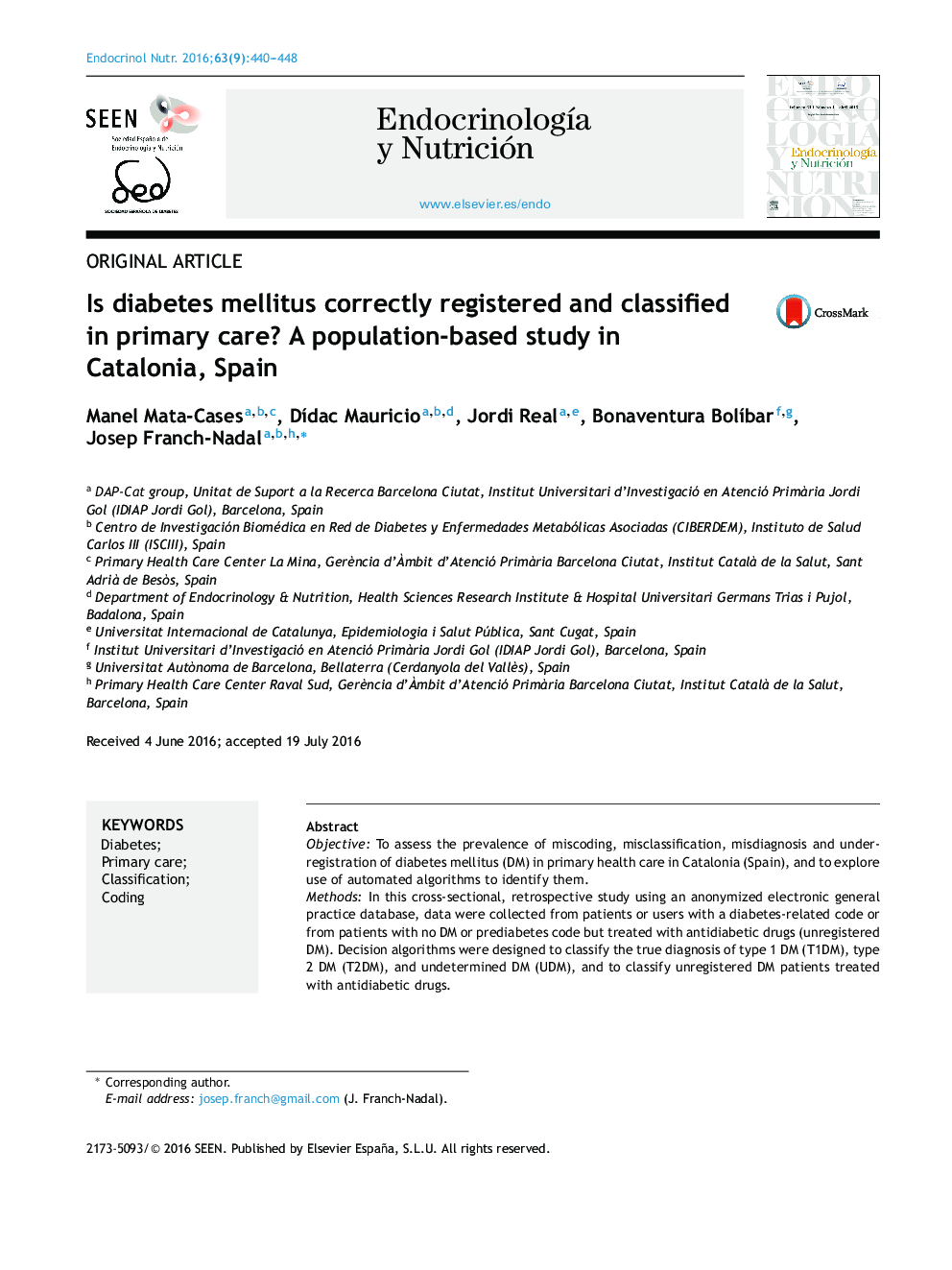| کد مقاله | کد نشریه | سال انتشار | مقاله انگلیسی | نسخه تمام متن |
|---|---|---|---|---|
| 5656052 | 1407335 | 2016 | 9 صفحه PDF | دانلود رایگان |
ObjectiveTo assess the prevalence of miscoding, misclassification, misdiagnosis and under-registration of diabetes mellitus (DM) in primary health care in Catalonia (Spain), and to explore use of automated algorithms to identify them.MethodsIn this cross-sectional, retrospective study using an anonymized electronic general practice database, data were collected from patients or users with a diabetes-related code or from patients with no DM or prediabetes code but treated with antidiabetic drugs (unregistered DM). Decision algorithms were designed to classify the true diagnosis of type 1 DM (T1DM), type 2 DM (T2DM), and undetermined DM (UDM), and to classify unregistered DM patients treated with antidiabetic drugs.ResultsData were collected from a total of 376,278 subjects with a DM ICD-10 code, and from 8707 patients with no DM or prediabetes code but treated with antidiabetic drugs. After application of the algorithms, 13.9% of patients with T1DM were identified as misclassified, and were probably T2DM; 80.9% of patients with UDM were reclassified as T2DM, and 19.1% of them were misdiagnosed as DM when they probably had prediabetes. The overall prevalence of miscoding (multiple codes or UDM) was 2.2%. Finally, 55.2% of subjects with unregistered DM were classified as prediabetes, 35.7% as T2DM, 8.5% as UDM treated with insulin, and 0.6% as T1DM.ConclusionsThe prevalence of inappropriate codification or classification and under-registration of DM is relevant in primary care. Implementation of algorithms could automatically flag cases that need review and would substantially decrease the risk of inappropriate registration or coding.
ResumenObjetivoEvaluar la prevalencia de errores en la codificación, clasificación, diagnóstico e infrarregistro de la diabetes mellitus (DM) en asistencia primaria en Cataluña y explorar el uso de algoritmos automáticos para identificarlos.MétodosEn este estudio transversal, retrospectivo utilizando una base electrónica de datos anonimizados se extrajeron los datos de pacientes con algún código de diabetes o de pacientes sin código de DM o prediabetes pero tratados con antidiabéticos (DM no registrada). Se diseñaron algoritmos de decisión para clasificar el verdadero diagnóstico de diabetes tipo 1 (DM1), diabetes tipo 2 (DM2) y diabetes indeterminada (DMI), y para clasificar a los pacientes con DM no registrada tratados con antidiabéticos.ResultadosSe obtuvieron datos de un total de 376.278 sujetos con algún código ICD-10 de DM y de 8.707 pacientes sin código de DM o prediabetes tratados. Tras la aplicación de los algoritmos, un 13,9% de pacientes con DM1 se reclasificaron como DM2; un 80,9% de pacientes con DMI se reclasificaron como DM2 y un 19,1%, como prediabetes. La prevalencia global de errores de codificación (códigos múltiples o DMI) fue del 2,2%. Finalmente, el 55,2% de los sujetos con DM no registrada fueron clasificados como prediabetes, el 35,7% como DM2, el 8,5% como DMI tratada con insulina y el 0,6% como DM1.ConclusionesLa prevalencia de DM inadecuadamente codificada, clasificada o infrarregistrada en asistencia primaria es relevante. La aplicación de algoritmos podrÃa etiquetar automáticamente los casos que necesitan revisión y reducir considerablemente el riesgo de codificaciones erróneas.
Journal: EndocrinologÃa y Nutrición (English Edition) - Volume 63, Issue 9, November 2016, Pages 440-448
